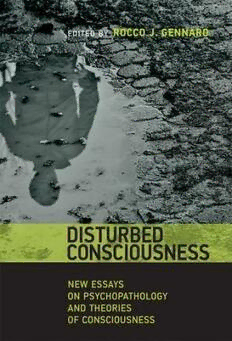Table Of ContentDisturbed Consciousness
Philosophical Psychopathology
Jennifer Radden and Jeff Poland, editors
Disturbed Consciousness: New Essays on Psychopathology and Theories of Consciousness,
Rocco J. Gennaro, editor (2015)
Being Amoral: Psychopathy and Moral Incapacity, Thomas Schramme, editor (2014)
A Metaphysics of Psychopathology, Peter Zachar (2014)
Classifying Psychopathology: Mental Kinds and Natural Kinds, Harold Kincaid and Jac-
queline A. Sullivan, editors (2014)
The Ethical Treatment of Depression: Autonomy through Psychotherapy, Paul Biegler
(2011)
Addiction and Responsibility, Jeffrey Poland and George Graham, editors (2011)
Psychiatry in the Scientific Image, Dominic Murphy (2006)
Brain Fiction: Self-Deception and the Riddle of Confabulation, William Hirstein (2004)
Imagination and Its Pathologies, James Phillips and James Morley, editors (2003)
Imagination and the Meaningful Brain, Arnold H. Modell (2003)
When Self-Consciousness Breaks: Alien Voices and Inserted Thoughts, G. Lynn Stephens
and George Graham (2000)
The Myth of Pain, Valerie Gray Hardcastle (1999)
Divided Minds and Successive Selves: Ethical Issues in Disorders of Identity and Personality,
Jennifer Radden (1996)
Philosophical Psychopathology, George Graham and G. Lynn Stephens, editors (1994)
Disturbed Consciousness
New Essays on Psychopathology and Theories of Consciousness
edited by Rocco J. Gennaro
The MIT Press
Cambridge, Massachusetts
London, England
© 2015 Massachusetts Institute of Technology
All rights reserved. No part of this book may be reproduced in any form by any
electronic or mechanical means (including photocopying, recording, or information
storage and retrieval) without permission in writing from the publisher.
MIT Press books may be purchased at special quantity discounts for business or sales
promotional use. For information, please email [email protected].
This book was set in Stone by the MIT Press. Printed and bound in the United States
of America.
Library of Congress Cataloging-in-Publication Data
Disturbed consciousness : new essays on psychopathology and theories of
consciousness / edited by Rocco J. Gennaro.
pages cm—(Philosophical psychopathology)
Includes bibliographical references and index.
ISBN 978-0-262-02934-6 (hardcover : alk. paper)
1. Psychology, Pathological. I. Gennaro, Rocco J.
RC454.D558 2015
616.89—dc23
2015001895
10 9 8 7 6 5 4 3 2 1
Contents
Acknowledgments vii
1 Psychopathologies and Theories of Consciousness: An Overview 1
Rocco J. Gennaro
2 Jaspers’ Dilemma: The Psychopathological Challenge to Subjectivity
Theories of Consciousness 29
Alexandre Billon and Uriah Kriegel
3 Somatoparaphrenia, Anosognosia, and Higher-Order Thoughts 55
Rocco J. Gennaro
4 Consciousness, Action, and Pathologies of Agency 75
Myrto Mylopoulos
5 Self, Belonging, and Conscious Experience: A Critique of Subjectivity
Theories of Consciousness 103
Timothy Lane
6 From Darwin to Freud: Confabulation as an Adaptive Response to
Dysfunctions of Consciousness 141
Paula Droege
7 Self-Deception and the Dolphin Model of Cognition 167
Iuliia Pliushch and Thomas Metzinger
8 Disorders of Unified Consciousness: Brain Bisection and Dissociative
Identity Disorder 209
Andrew Brook
9 Altogether Now—Not! Integration Theories of Consciousness and
Pathologies of Disunity 227
Robert Van Gulick
vi Contents
10 Consciousness despite Network Underconnectivity in Autism:
Another Case of Consciousness without Prefrontal Activity? 249
William Hirstein
11 A Schizophrenic Defense of a Vehicle Theory of Consciousness 265
Gerard O’Brien and Jon Opie
12 Prediction Error Minimization, Mental and Developmental Disorder,
and Statistical Theories of Consciousness 293
Jakob Hohwy
13 Passivity Experience in Schizophrenia 325
Philip Gerrans
14 From a Sensorimotor Account of Perception to an Interactive
Approach to Psychopathology 347
Erik Myin, J. Kevin O’Regan, and Inez Myin-Germeys
Contributors 369
Index 373
Acknowledgments
I would like to thank all of the contributors to this volume. Thanks also
to Phil Laughlin of the MIT Press for helping to bring this project forward,
especially during the early stages. I also wish to thank the University of
Southern Indiana for a 2012 Faculty Research and Creative Work Grant
Award under the heading “Psychopathology and Consciousness” that
enabled me to attend and present at the sixteenth annual meeting of the
Association for the Scientific Study of Consciousness, the University of Sus-
sex, Brighton, UK, in July 2012.
1 Psychopathologies and Theories of Consciousness: An
Overview
Rocco J. Gennaro
The basic idea for this volume is for authors to defend, discuss, or critique at
least one specific philosophical theory of consciousness with respect to one
or more psychopathologies. Each essay brings together at least one theory
and one psychopathology in a substantial way. Authors were asked to keep
in mind such questions as: How can a (or your) theory of consciousness
account for a specific psychopathological condition? How might one reply
to an actual (or potential) criticism of your theory of consciousness based
on a psychopathology? How might one theory of consciousness explain a
psychopathology better than another theory? What difficulties arise for a
specific theory of consciousness given the existence of one or more of these
psychopathologies? Some work had already been done along these lines,
particularly with respect to the higher-order thought (HOT) theory of con-
sciousness on, for example, visual agnosia, autism, and somatoparaphrenia
(such as Liang and Lane 2009, Rosenthal 2010, Gennaro 2012), but the
time is ripe for further work with respect to various theories of conscious-
ness (more on these theories in section 3 of this introduction). In the end,
my hope is that this volume will help to spur much more interdisciplinary
work along these lines.
1 A Brief Introduction to Philosophical Psychopathology
Philosophers have of course long been intrigued by disorders of the mind
and consciousness. Part of the interest is presumably that if we can under-
stand how consciousness goes wrong, then that will help us to theorize
about the normal, functioning mind. Going back at least as far as John
Locke (1689/1975), there has been discussion about the philosophical
implications of multiple personality disorder (MPD), which is now called
dissociative identity disorder (DID). Questions abound: Could there be two
centers of consciousness in one body or brain? What makes a person the

